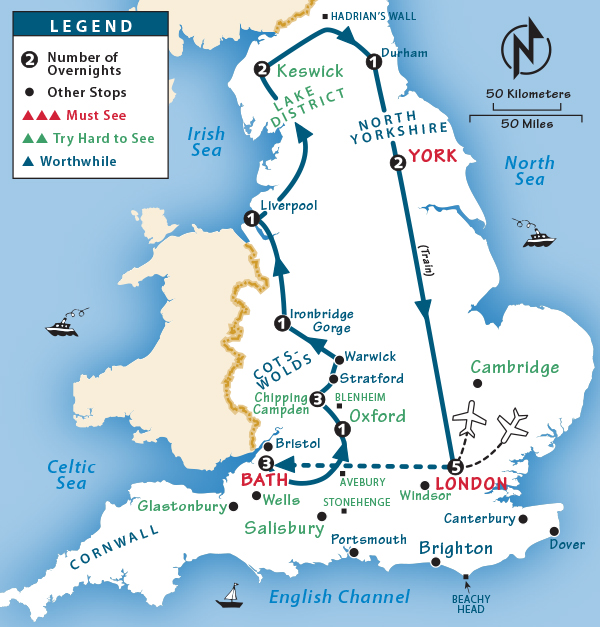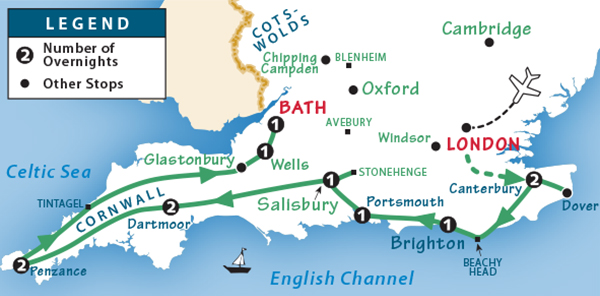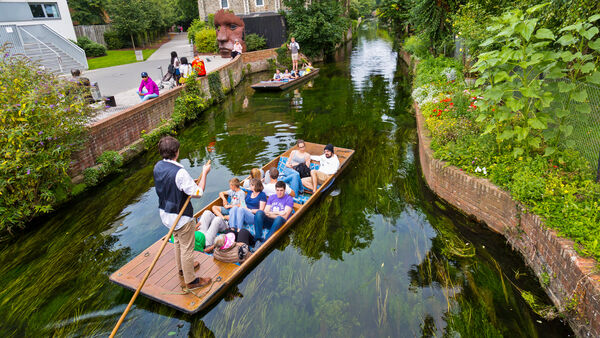England Itinerary
By Rick Steves
So much to see, so little time. How to choose? To help you get started, I've listed my top picks for where to go in England, and my plan for your best three-week trip. (If you're considering adding Scotland and/or Wales, see my recommended itinerary for all of Great Britain.)
Depending on the length of your trip, and taking geographic proximity into account, here are my recommended priorities:
- 3 days: London
- 5 days, add: Bath and nearby sights (take a minibus tour or choose some combination of Stonehenge, Avebury, Wells, Glastonbury, and Salisbury)
- 7 days, add: Cotswolds
- 9 days, add: York
- 11 days, add: Lake District
- 14 days, add: Durham, Stratford, and Warwick or Blenheim
- 17 days, add: Ironbridge Gorge, Liverpool
- 21 days, add: Cornwall, Dartmoor
- 24 days, add: Choose two of the following — Cambridge, Oxford, Blackpool, Coventry, Portsmouth, Brighton, Canterbury, or Dover
The recommended itineraries below give you an idea of how much of England's top sights you can reasonably see in three weeks, but of course you can adapt them to fit your own interests and time frame.
If you enjoy big cities, you could easily spend a week in London. If villages beckon, linger in the Cotswolds, where time has all but stopped. York and Bath are inviting, walkable towns with fascinating sights. Nature lovers get wonderfully lost in the Lake District and Dartmoor.
History buffs can choose their era: prehistoric (Stonehenge, Avebury), ancient Roman (Bath, Hadrian's Wall), religious (Canterbury), medieval (York, Warwick Castle), Industrial Revolution (Ironbridge Gorge), or royal (Tower of London, Windsor, Blenheim Palace).
Literary fans make pilgrimages to Stratford (Shakespeare), Bath (Austen), and the Lake District (Wordsworth and Potter). Beatles fans from here, there, and everywhere head to Liverpool. For amusement pier fun, stroll the arcades at the coastal resorts of Brighton or Blackpool.
Rick’s Best Three-Week Trip to England by Car
This 20-day itinerary covers the top sights in England.
 Day 1: Arrive in London, connect to Bath (sleep in Bath)
Day 1: Arrive in London, connect to Bath (sleep in Bath)
Day 2: Bath (sleep in Bath)
Day 3: Pick up car, visit Stonehenge, Wells, and Glastonbury (sleep in Bath)
Day 4: Avebury, Blenheim Palace (sleep in Oxford)
Day 5: Oxford, to the Cotswolds in the evening (sleep in Chipping Campden)
Day 6: Explore the Cotswolds (sleep in Chipping Campden)
Day 7: More Cotswolds, plus evening in Stratford if you've booked a play (sleep in Chipping Campden)
Day 8: Stratford, Warwick Castle, to Ironbridge Gorge (sleep in Ironbridge Gorge)
Day 9: Ironbridge Gorge, then Liverpool (sleep in Liverpool)
Day 10: To the Lake District, visiting the South Lake District en route to Keswick (sleep in Keswick area)
Day 11: Explore the North Lake District; hikers may want an extra day here (sleep in Keswick area)
Day 12: Hadrian's Wall, then to Durham (sleep in Durham)
Day 13: North Yorkshire, drop car in York (sleep in York)
Day 14: York (sleep in York)
Day 15: Morning train to London (sleep in London)
Day 16: London (sleep in London)
Day 17: London (sleep in London)
Day 18: Day trips: Windsor, Cambridge, Brighton, or Canterbury/Dover (sleep in London)
Day 19: London or another day trip (sleep in London)
Day 20: Whew!
With More Time
You can easily combine the 20-day itinerary above with my 11-day "South England Drive" (below): Start with the south itinerary, ending in Bath, then continue with Day 4 of the main itinerary (Avebury and Blenheim to Oxford).
Rick’s Best Three-Week Trip to England by Public Transportation
This 21-day itinerary connects England's top destinations by train and bus, with minibus tour options along the way. Keep in mind that bus service can be scarce on Sundays (particularly around the Cotswolds and Stratford).
Day 1: Arrive in London, connect to Bath by train or bus (1.5 hours; sleep in Bath)
Day 2: Bath (sleep in Bath)
Day 3: Stonehenge and Avebury by minibus day tour (sleep in Bath)
Day 4: To Oxford by train (1 hour; sleep in Oxford)
Day 5: Blenheim Palace by bus (1 hour round-trip; sleep in Oxford)
Day 6: To the Cotswolds by train to Moreton-in-Marsh (0.5 hour), then bus to Chipping Campden (0.5 hour; sleep in Chipping Campden)
Day 7: Explore Cotswolds (sleep in Chipping Campden)
Day 8: To Stratford by bus (0.5 hour; sleep in Stratford)
Day 9: To Liverpool by train (3 hours; sleep in Liverpool)
Day 10: To the Lake District by train to Penrith, then bus to Keswick (sleep in Keswick area)
Day 11: Explore the North Lake District (sleep in Keswick area)
Day 12: To Hadrian's Wall by bus to Penrith and train to Haltwhistle (2 hours), then explore the wall by shuttle bus or taxi (sleep in Haltwhistle area or Durham)
Day 13: To Durham by train from Hexham (1 hour), then Beamish Museum by bus (1 hour round-trip; sleep in Durham)
Day 14: To York by train (1 hour; sleep in York)
Day 15: York (sleep in York)
Day 16: Morning train to London (2 hours; sleep in London)
Day 17: London (sleep in London)
Day 18: London (sleep in London)
Day 19: Day trips: Windsor, Cambridge, Brighton, or Canterbury/Dover (sleep in London)
Day 20: London or another day trip (sleep in London)
Day 21: Whew!
With Less Time
To shorten this trip, skip places where public transportation is particularly sparse or time-consuming (such as Hadrian's Wall).
Rick’s South England Drive
South England is best by car and worth a full week or more. Consider this 11-day trip from Canterbury to Cornwall to Bath.
 Day 1: Arrive in London, train to Canterbury (sleep in Canterbury)
Day 1: Arrive in London, train to Canterbury (sleep in Canterbury)
Day 2: Canterbury, pick up car, visit Dover (sleep in Canterbury)
Day 3: Battle of Hastings site, then Beachy Head (sleep in Beachy Head or Brighton)
Day 4: Brighton, then Portsmouth (sleep in Portsmouth)
Day 5: More Portsmouth, then Salisbury (sleep in Salisbury)
Day 6: Stonehenge (early), then Dartmoor National Park (sleep in Dartmoor)
Day 7: Dartmoor National Park (sleep in Dartmoor)
Day 8: Cornwall (sleep in Penzance)
Day 9: Explore Cornwall's Penwith Peninsula (sleep in Penzance)
Day 10: Tintagel, then Glastonbury (sleep in Wells)
Day 11: Wells, then Bath (sleep in Bath)
Without a Car
While less ideal, it's possible to see most of the south by train or bus. Do the southeast sights (Canterbury, Dover, Brighton) as day trips from London. Skip Dartmoor and reach Penzance and Cornwall by train (and tour the peninsula via minibus from Penzance). Then visit Wells and Glastonbury by bus from Bath.


